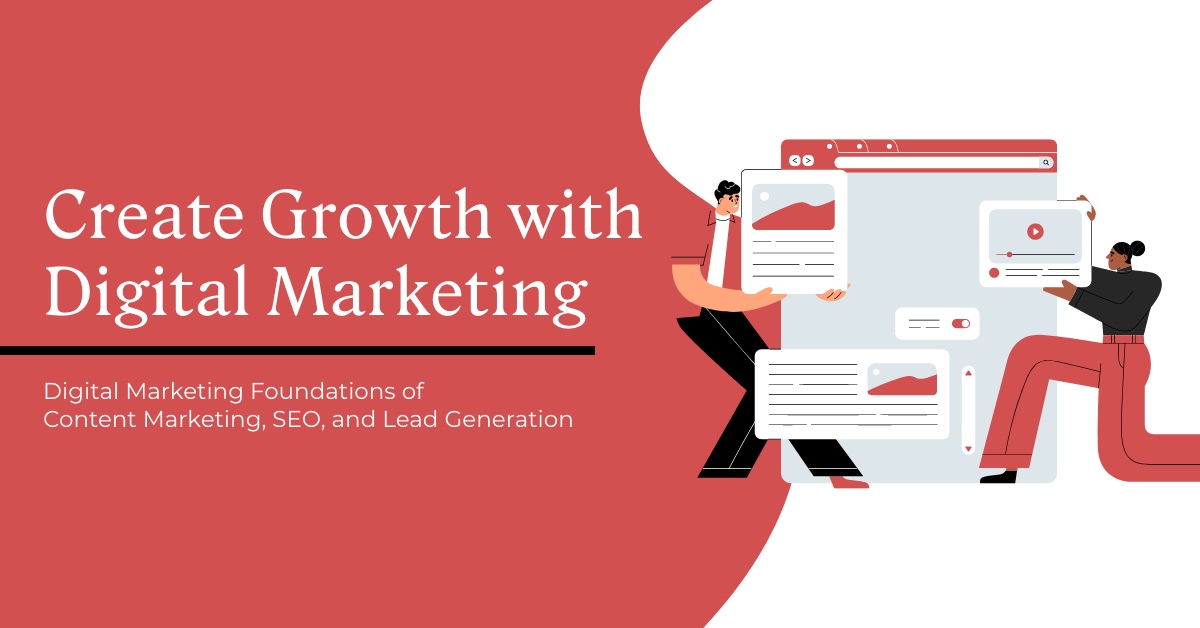
A strong digital marketing process starts at the foundation.
Just like building a home, a strong digital presence comes from a solid foundation across central pillars that determine your success. At the Nine, we focus client success on three areas:
But as online sales now dominate, manufacturers and service-providers are having to rethink their marketing strategies.
According to Statista, last year over a quarter of the world’s population—or, about 2 billion people—made a purchase online. These purchases totaled more than $4.2 trillion.
To reach more customers, digital marketing budgets are increasing across sectors. Emarketer.com shares that between the years 2017 and 2019, U.S. companies increased digital advertising spending by over 19% each year.
These increased budgets go straight into foundation building by promoting their products and services using three key strategies: content marketing, search-engine optimization (SEO), and lead generation/digital advertising.
Content Marketing: The First Pillar of Digital Marketing
Step 1: Listening

The foundation of content marketing is listening—to yourself, your team, your leadership, and your customers.
What does listening to yourself mean?
It starts with a vision statement that addresses the following questions:. Why do you exist as a company? What kind of product or service does your company aim to provide? What are the firm’s long-term goals? The answers to these questions will help you create a concise and clear statement of your company’s vision.
For example, Southwest Airlines’ vision is “to be the world’s most loved, most efficient, and most profitable airline.”
After you’ve established your vision statement, start listening to other people by interviewing or surveying customers, getting feedback from team members, and reading customer reviews.
As you truly start listening, the “voice of the customer” (VOC) will become clear. This distinct voice will help you create effective:
campaigns,
advertisements,
social media posts,
and landing pages.
Step 2: Creating Messages, Stories, and Archetypes
The next step is discerning your company’s most important messages, stories, and archetypes.
What you want to share about your company with the world becomes your messages. For example, 80 Acres Farms in Ohio wanted to convey they were the “future of fresh food.” This translated to “The Future of Fresh” as their primary message.
Stories are records of positive customer experiences. They can come from reviews, testimonies, and even interviews you conduct.
Archetypes are general descriptions of customer values and motivations. For example, a firm could see their customers as “jesters” who value spontaneity and fun.
These messages, stories, and archetypes help you better understand how to market to both your current and future customers.
Additionally, the stories you’ve collected, along with the messages and customer archetypes you’ve created, will create a distinct voice.
The Nine can help with this step by using an AI tool called Vox Verba. Vox Verba listens to information you provide—such as stories and archetypes—then gives you phrases, direction and positioning.
In the end, you will have exactly what you need to speak to your customers in an authentic voice, unique to your firm.
Step 3: Trackable Media

The third step of content marketing is creating and sharing trackable media.
Sometimes a marketing team will create amazing media and share that media without any means of tracking its effectiveness.
In other cases, a marketing team will effectively track media but not know how the numbers they’re tracking relate to sales and leads.
Even if your media is top-notch, without effective tools or data insights, you’ll get nowhere. To help you create content for platforms like Instagram and Facebook, we use Wave Video. Wave Video allows us to rework images and videos into engaging social media content.
Next, and more importantly, we’ll use Sprout Social to manage your content. Sprout Social gives us detailed data so we can uncover trends and get insights about the content you’re sharing. With this data we can see what’s working and turn your posts into profits!
SEO: The Second Major Pillar of Digital Marketing

The second major pillar of digital marketing is search-engine optimization (or SEO).
Almost 100% of clicks go to page one search-engine results and a little over 50% to the top three hits. Thus, it’s essential that your website placement is as high as possible in Google’s search results.
Good SEO brings targeted traffic (motivated, qualified buyers) to your site resulting in higher sales.
But what goes into good search-engine optimization?
Step 1: Keyword Research
The first step in improving your site’s SEO is keyword research.
Keyword research is finding out how people are searching for your products and then creating content from those findings.
An excellent keyword search tool, and one The Nine uses, is SEMRush.
SEMRush allows us to pull keywords for a given web address as well as see a list of all the keywords the site is ranking for on Google. You can also enter a keyword and SEMRush will give you related searches. For example, enter “Tuscaloosa Italian food” and SEMRush may provide you with “Italian food near me”, “Tuscaloosa Italian market,” et cetera.
Another useful SEMRush feature is month-to-month keyword tracking, used to follow a company’s online growth. For example, a start-up shoe company might see more people searching for “comfortable walking shoes” and use that insight to steer customers to their site.
But The Nine doesn’t stop there! Not only do we research keywords relevant to your business—we also consider your competitors.
That’s correct. We study your competition’s keywords and rankings to have a clear idea of what’s working—or not working—then use that to your advantage. At The Nine we leave no stone (or keyword) unturned!
Step 2: Content Strategy
The second step in improving your site’s SEO is establishing a content strategy.
Your perceived authority is KEY to rising to the top of search results. Google recognizes your authority when you have a “crawl-able” site. A crawl-able site is a site where Google’s “spiders” (or bots used to index the Web) are able to retrieve every link on your site.
A spider’s ability to crawl a site may be affected if it can’t explore a webpage’s contents or find links to other webpages on your site. We make sure your site is “crawl-able” by ensuring there are links to other webpages and that every link is retrievable.
Another way to charm Google is with quality content. If another site owner believes your content is reliable enough to link to, your content is probably trustworthy. Trustworthy content gets you in Google’s good graces.
The final part of content strategy is internal linking, or the connection of webpages within your site (like your homepage linking to your product page). This component is one many people fail to consider (and one we cannot stress enough)!
A crawl-able site, quality content, and internal links will all score you major Google (and SEO) brownie points!
Step 3: Website Structure
The final leg of the SEO stool is website structure. This includes the global navigation and global footer (the top and bottom menus that appear on every webpage). If you want to rank higher on search engine results, the structure of your website is KEY.
Website structure and internal linking are two of the most overlooked parts of SEO, which is why they are some of the first things we look at when working with you.

Lead Generation & Advertising: The Third Major Pillar of Digital Marketing
The final components of the digital marketing process are lead generation and advertising online. In this step, we find Internet users with the potential to become customers and advertise to them. We help you conduct a full-scale sales and leads audit by asking questions like:
How much are my competitors spending on search ads?
How can I be found more often when people are searching online?
How can I determine my marketing budget for sales and leads?
Step 1: Finding Your Audience & Converting Them to Customers
The first step in lead generation and advertising online is finding your audience.
What is their industry?
What is their level of intent—low (casually viewing an advertisement), medium (someone who’s come to your site and looked around), or high (clicked on your advertisement and/or came to your site and looked around and bought one of your products)?
Also to be considered is what your offer to potential buyers entails.
Is it attractive due to a discount or buy-one, get-one (BOGO) promo?
Is a form of risk reversal (such as a testimonial from past customers) included, giving potential customers a feeling of safety?
Is free shipping or other bonus(es) offered??
And finally, is there a sense of urgency (“available for a limited time”) that prompts someone to buy your product right then and there?
Attractiveness, risk reversal, bonus(es), and sense of urgency are all important considerations when creating an offer for your online audience.

Vox Verba’s AI Storytelling Tool and the idea of archetypes can help us reword your message to reach a specific group of people. For example, maybe we’ve discovered your target audience identifies as “sages.” You can then word—or reword—your ad’s copy from the point of view of gaining knowledge. For example: These books will help you understand Socrates’ teachings.
Another useful lead generation and advertising tool is Leadsbridge. Leadsbridge allows us to view leads collected from online platforms such as LinkedIn, Google, and Facebook in real time and send these leads to anyone at any time.
A final leads and advertising tool is Morphio. Morphio is an AI-powered software that allows us to track the advertising and leads numbers our clients care about (like budgets and conversions). That way we ensure our clients are moving in the right direction across each platform they’re using. It also ensures we stay on budget because it allows us to see our ad spend in real-time.
Step 2: Testing Your Ad(s)
Once you know your audience and have your offer ready, it’s time to test and track your ads.
In this step you’re figuring out what elements do—or do not—work.
Are people interacting enough with the ad (in other words, clicking on it)?
Is the ad converting its viewers to customers?
It’s also worth noting that of an ad’s four main parts—the hook (the image or video included with the ad), the headline, the post text, and the call-to-action—the hook is the most important, adding up to 85% of the viewer’s feelings about the ad. Because the hook has the biggest effect on an ad’s success, we help find the best hook(s) for your ad(s).
Step 3: Improving Your Ad(s)

Throughout your ad’s run, we collect and assess performance data to ensure the ad’s effectiveness.
This data may answer questions like:
What imagery is capturing your audience’s attention?
Which types of placements are most effective (position on page, platform used)?
Which offers are most enticing?
In the words of Paris Vega, our Growth Director, our goal is to “transform your marketing budget into [a] measurable investment in your company’s growth.”
Each of our digital marketing services—from SEO to content marketing—starts with over 50 steps each designed to elevate your online presence and meet your business goals. Using the various tools we discussed, we can often reach these goals with a smaller marketing budget and less advertising spend than in the past.
If you’re interested in strengthening your online presence, getting more leads, and increasing your revenue don’t wait to reach out to us. With the right support, your company can reach higher goals than ever before by partnering with the Nine.
